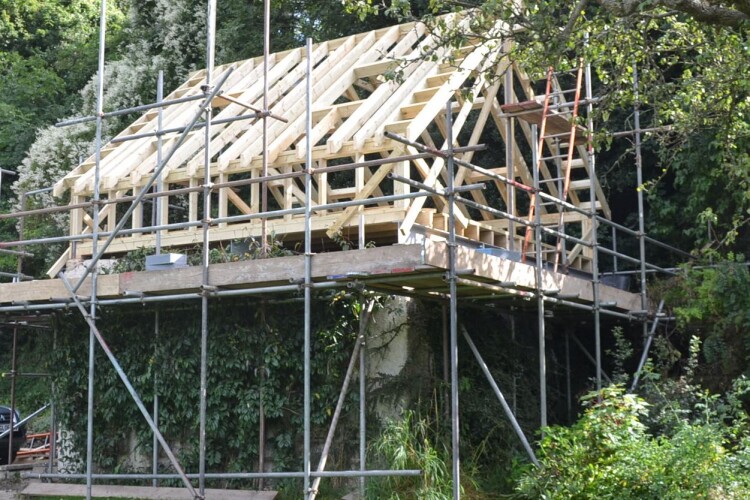According to the Department for Environment, Food & Rural Affairs (Defra), using timber in construction is one of the best ways to reduce emissions from buildings.
Defra not only wants the UK to build more with timber, but also rely less on imports for the material. Currently 80% of the timber used in the UK is imported.
Called Timber in construction roadmap, the document suggests that left to the market, the use of timber in construction will not expand because not enough people want to use it. We will continue to have timber-framed low rise houses but getting developers to embrace engineered mass timber for taller structures or insurers to support the use volumetric wooden homes built in factories will not progress without government intervention – without government telling engineers and architects that they are using the wrong materials.
The document outlines the opportunities and barriers to the use of timber in construction in England, centred around seven priority themes:
- improving data on timber and whole life carbon
- promoting the safe, sustainable use of timber as a construction material
- increasing skills, capacity, and competency across the supply chain
- increasing the sustainable supply of timber
- addressing fire safety and durability concerns to safely expand the use of engineered mass timber
- increasing collaboration with insurers, lenders, and warranty providers
- promoting innovation and high performing timber construction systems.
The government’s justification for promoting timber is based purely on its sustainability credentials, not whether it is actually he best material with which to build from an engineering perspective. It recognises the fire safety concerns and resistance from financial markets but this can all be overcome, it believes.
“Promoting the use of timber as a building material is a key part of the government’s net zero strategy,” said environment minister Rebecca Pow. “It will innovate the economy, play a role in creating green jobs and also help meet our tree-planting targets.”
All of the supply-side vested interests are behind the roadmap, including the Forestry Commission, the Confederation of Timber Industries (CTI), Timber Development UK (TDUK) and the Confederation of Forest Industries (Confor).
Timber Development UK chief executive David Hopkins said: “Timber construction has been recognised as essential to tackling built environment emissions by key advisory bodies such as the Environmental Audit Committee and Climate Change Committee. We are delighted to see the government action the recommendations of these bodies through the long-awaited Timber in Construction policy roadmap.
“By expanding low-carbon timber construction, particularly in the housing sector, we can decarbonise our built environment whilst simultaneously building high quality, efficient buildings. Expanding timber construction also offers a range of economic benefits, helping regions to ‘level up’ with green jobs, and creating localised manufacturing bases across the country which add value to raw timber products.”

Structural Timber Association chief executive Andrew Carpenter said: “We are delighted that the UK government has recognised the critical need to safely increase the use of timber in construction and we applaud the leadership that has been shown in setting this objective.
“The TIC Roadmap will be a beneficial driver in this effort, which is so vital to meeting the UK’s net zero carbon commitments, giving clarity and guidance to stakeholders throughout the construction industry. It has been a pleasure to participate in such important work and we look forward to continued collaboration between government and industry as we move to the next stage of implementation.”
Confederation of Timber Industries chair Alex Goodfellow said: “The government must provide both effective environmental regulation and market incentives to expand timber construction in the UK. The roadmap provides a solid foundation in achieving this aim, setting out real intent from the government to tackle the barriers to timber construction.”
“However, there are areas of the report, particularly in relation to embodied carbon, which we feel need to be bolder. It is a shame to see the government delay action on this to 2025. The CTI will continue to work with all political parties in the long term, to ensure these positive commitments are both actioned, and in some cases, expanded.”
The document was previewed by journalist-turned-farmer Jeremy Clarkson in his Sunday Times column last weekend.
“Enthusiasts of this monobrowed neolithicism say that Westminster Hall in the Houses of Parliament has a wooden roof and I’m sure they’re right. But the Shard does not. And nor does that triangle thing outside the Louvre. We’ve moved on,” Clarkson wrote. “I recently built a house which has a steel backbone, because when you use RSJs, you can have rooms which are bigger than a public convenience. And you don’t have to live in constant fear that the very skeleton of your house is being eaten by worms and could, at any moment, collapse on to your head.”
Clarkson concluded: “This is all so shoulder-saggingly dismal. It’s the sort of make-do-and-mend mentality that causes people to buy ready-made meals from the supermarket, rather than cook some actual food. Or buy a dreary hybrid. Or drink Starbucks coffee. I saw someone the other day wearing homemade wellingtons. And I thought: this was the country that created the Lightning interceptor.
“And now, to achieve net zero and provide affordable houses for hard-working families in the community, we are going to be asking people to live in cabins, like flies, until one day, they are consumed by fire.
“I have a better idea. Let’s not. Let’s use stone instead because there’s a limitless supply. You’re literally standing on it every time you go outside. And it can’t be eaten by deer or squirrels or worms, and contrary to what Steve Barclay might think, it’s an environmental irrelevance because it’s inert. Plus, a house built from stone is usually pretty to look at, whereas a house made from MDF usually isn’t.”
Got a story? Email news@theconstructionindex.co.uk



